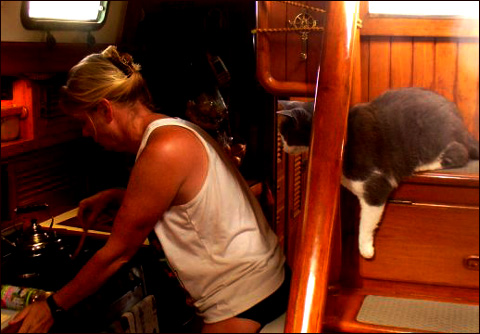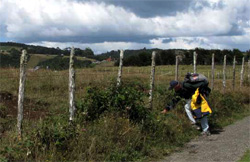 |
Jelly, the ship cat supervises Marcie in the galley. |
2 sinks with a faucet that has an extendable hose from the nozzle that I love. We have both fresh water and salt water foot pumps which are used most when we're underway. Even with a watermaker, I use salt water for rinsing dishes when we're underway (just in case).
We do not have a gen set, but do have an inverter. That said, we hate wasting power or running the engine, so use no electrical appliances aboard when we're sailing or at anchor.
We have a 3-burner Force 10 propane stove with oven. We have a small microwave which is only used when we're in a marina or motoring and used primarily for popping popcorn and quick heat-ups. I stow extra pots in the oven when not in use and all my silicone bakeware inside the microwave.
I don't have a lot of specialized cookware or gadgets, but I do have a good versatile set of Calphalon pots (3 sauce pans and a soup pot plus 2 frypans) -- most of which hang on the wall opposite the galley working area. I originally had cheaper pots (heck, we were at sea!) and upgraded at the first opportunity. I've been very impressed lately by the silicon bakeware. They bake well, wear well and are easy to stow. I have 2 each round, square, loaf pans, muffin tins and 2 aluminum pizza pans (which I also use as baking sheets).
Refrigeration set-up is a 2-compartment fridge and freezer, Adler-Barbour. It works relatively well, but it's small. We don't have ice nor can we keep ice cream frozen. I stock up on tinned veggies, etc. when we're able and have lately started canning meats and veggies/fruits (that I cannot find tinned) for extended passages. I obviously get fresh when I can, but on passages over a few weeks, it's hard to maintain an extensive fresh larder.
 |
|
 |
Picking moras (blackberries) in Chile |
|
David collecting mussels in Nova Scotia |
We have a BBQ attached to the aft rail, but rarely use it. The little propane cylinders so easily available & cheap in the USA are not available elsewhere or if they are, they're expensive. We had a direct connect to our propane tank, but felt it wasted too much propane. |